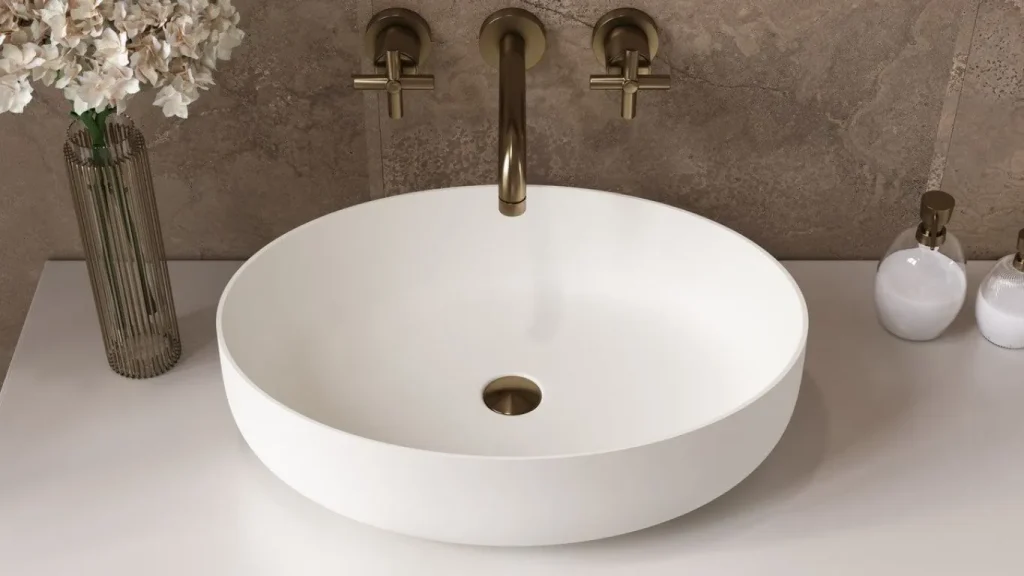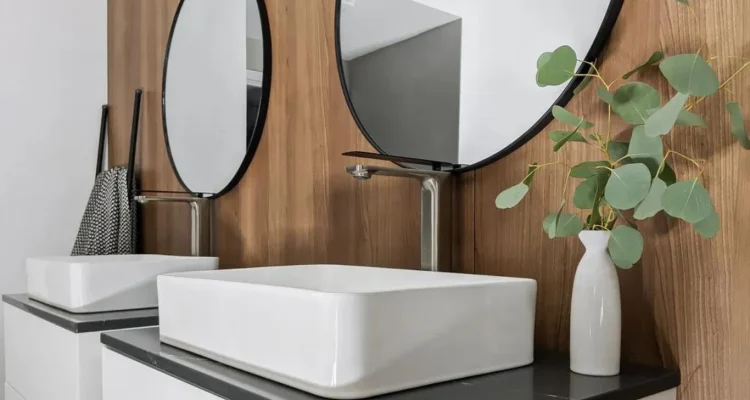Introduction to Vessel Sinks
Vessel sinks have revolutionized bathroom aesthetics, offering a unique focal point that blends functionality with contemporary design. Unlike traditional sinks that are recessed into the countertop or vanity, vessel sinks sit atop the surface, resembling a standalone bowl or basin. This distinctive positioning not only elevates the visual appeal of the bathroom but also provides practical benefits in terms of customization and style.

Defining Vessel Sinks
A vessel sink, also known as a countertop sink or above-counter sink, is a basin that rests on top of a bathroom vanity or countertop rather than being set within it. This design allows for a more prominent display of the sink’s material and shape, making it a striking centerpiece in modern bathroom design schemes.
The Evolution of Vessel Sinks in Bathroom Design
Early Origins and Traditional Use
Historically, vessel sinks trace their origins to ancient civilizations such as the Egyptians and Greeks, who used stone and metal bowls atop furniture for washing and bathing rituals. These early iterations were not only functional but also symbolized status and luxury.
Rise in Popularity: Modern Trends
In recent decades, vessel sinks have experienced a resurgence in popularity, driven by their versatility and aesthetic appeal. Modern advancements in materials and manufacturing techniques have expanded the range of options available, catering to diverse tastes and interior design preferences.
Types of Vessel Sinks
Vessel sinks are available in a wide array of materials, shapes, and styles to suit various bathroom décors. Here are some common types:
Glass Vessel Sinks
Glass vessel sinks offer a sleek and contemporary look, available in a spectrum of colors and designs. They can create a stunning visual impact, especially when paired with modern bathroom fixtures and lighting.
Stone and Marble Vessel Sinks
Stone and marble vessel sinks exude elegance and durability. These natural materials offer unique textures and patterns, adding a touch of luxury to any bathroom setting.
Ceramic and Porcelain Vessel Sinks
Ceramic and porcelain vessel sinks are classic choices known for their durability and ease of maintenance. They come in various shapes and finishes, from glossy white to intricate hand-painted designs.
Metal Vessel Sinks
Metal vessel sinks, such as those made from stainless steel or copper, provide a contemporary and industrial aesthetic. They are prized for their durability and resistance to corrosion.
Pros and Cons of Vessel Sinks
Advantages of Using a Vessel Sink
- Visual Appeal: Creates a focal point in the bathroom.
- Customization: Wide range of materials and styles available.
- Ease of Installation: Often simpler to install than undermount sinks.
Considerations Before Installing a Vessel Sink
- Height: Proper installation height for comfort and functionality.
- Spillage Risk: Potential for water splashing outside the sink due to its raised position.
- Compatibility: Ensuring compatibility with existing plumbing and vanity structure.
Choosing the Right Vessel Sink for Your Bathroom
Matching Your Bathroom Style
Select a vessel sink that complements your overall bathroom theme, whether it’s contemporary, traditional, or eclectic. Consider factors like color, shape, and material to harmonize with existing décor elements.
Size and Placement Considerations
Ensure the vessel sink’s dimensions are suitable for your vanity or countertop. It should provide ample space for washing while not overpowering the bathroom space visually.
Maintenance and Cleaning Tips
Different materials require specific care routines. For example, glass sinks may need regular polishing to maintain their clarity, while stone sinks should be sealed periodically to prevent stains.
Installing a Vessel Sink: Step-by-Step Guide
Preparing Your Vanity or Countertop
Measure and cut a hole in the countertop to accommodate the sink’s drain. Ensure the surface is level and stable to support the sink’s weight.
Installing the Drain and Faucet
Attach the drain and faucet to the sink according to the manufacturer’s instructions. Seal connections with plumber’s putty or silicone to prevent leaks.
Sealing and Securing the Sink
Apply a bead of silicone sealant around the sink’s base before setting it onto the countertop. Secure the sink in place and wipe away any excess sealant.
Vessel Sink vs. Undermount Sink: Which is Better?
Aesthetics and Visual Impact
Vessel sinks are favored for their striking appearance and ability to showcase the sink’s design. Undermount sinks, on the other hand, offer a seamless look that blends into the countertop.
Practical Considerations: Cleaning and Maintenance
Undermount sinks may be easier to clean as they are flush with the countertop, while vessel sinks require more attention to prevent water splashing and maintain cleanliness around the raised edges.
Enhancing Your Bathroom with Vessel Sink Accessories
Choosing the Right Faucet
Select a faucet that complements the height and style of your vessel sink. Wall-mounted faucets or tall vessel faucets are popular choices for maximizing both functionality and visual appeal.
Complementing Décor with Vessel Sink Vanities
Explore vanity options that enhance the vessel sink’s design. Floating vanities or furniture-style cabinets can provide additional storage while showcasing the sink.
Vessel Sinks in Different Bathroom Styles
Contemporary and Minimalist Bathroom Designs
In contemporary settings, sleek materials like glass or stainless steel vessel sinks can accentuate clean lines and minimalist aesthetics.
Rustic and Traditional Bathroom Settings
Natural stone or copper vessel sinks add warmth and texture to rustic or traditional bathroom décors, creating a cozy and inviting atmosphere.
Environmental Impact of Vessel Sinks
Sustainability of Materials Used
Opt for eco-friendly materials such as recycled glass or sustainably sourced wood for vanity bases to reduce environmental impact.
Water Efficiency Considerations
Choose faucets and sink designs that promote water conservation without compromising performance. Look for WaterSense-certified products for optimal efficiency.
Maintaining and Cleaning Your Vessel Sink
Daily Care and Cleaning Routine
Use mild soap and water to clean the sink regularly, avoiding abrasive cleaners that could damage the surface. Dry the sink after each use to prevent water spots.
Dealing with Stubborn Stains
For stubborn stains, such as mineral deposits or soap scum, use a non-abrasive cleaner recommended by the sink’s manufacturer. Avoid harsh chemicals that could affect the sink’s finish.
Common Misconceptions About Vessel Sinks
Installation Complexity and Cost Myths
While some may perceive vessel sinks as difficult to install or costly, modern advancements in plumbing fixtures and installation techniques have made them more accessible and affordable.
Durability and Longevity Concerns
With proper maintenance and care, vessel sinks can be as durable as traditional sinks. Choosing high-quality materials and professional installation can extend the sink’s lifespan.
FAQs About Vessel Sinks
What are vessel sinks made of?
Vessel sinks can be made from a variety of materials, including glass, ceramic, porcelain, stone (such as marble or granite), metal (like stainless steel or copper), and even composite materials. Each material offers unique aesthetics, durability, and maintenance requirements, allowing homeowners to choose based on their preferences and bathroom design.
Are vessel sinks practical for small bathrooms?
Yes, vessel sinks can be practical for small bathrooms depending on the sink’s size and placement. Choosing a compact vessel sink and pairing it with a suitable vanity or countertop can maximize space efficiency while still adding a stylish focal point to the bathroom.
Can vessel sinks be installed on any type of vanity?
Vessel sinks require a vanity or countertop that is specifically designed to accommodate their installation. The vanity or countertop should have a hole or opening cut out to fit the sink’s drain and should be sturdy enough to support the weight of the sink when filled with water.
How do vessel sinks affect plumbing installation?
Installing a vessel sink may require adjustments to the plumbing configuration, especially if the sink sits higher than traditional sinks. It’s essential to ensure that the faucet height and placement are compatible with the sink’s design to prevent splashing and optimize water flow.
Are vessel sinks easy to clean and maintain?
The ease of cleaning and maintenance of vessel sinks depends on the material chosen. Smooth materials like glass, ceramic, and stainless steel are generally easier to clean with regular soap and water. Porous materials such as natural stone may require periodic sealing to prevent stains and maintain their appearance.
Conclusion
Vessel sinks continue to be a popular choice in modern bathroom design, offering homeowners a blend of functionality and aesthetic appeal. Whether you’re renovating your bathroom or planning a new construction, considering a vessel sink can elevate the overall look and feel of your space. With a wide range of materials, styles, and installation options available, you can find a vessel sink that complements your personal style and enhances your bathroom’s ambiance.


Congratulation!